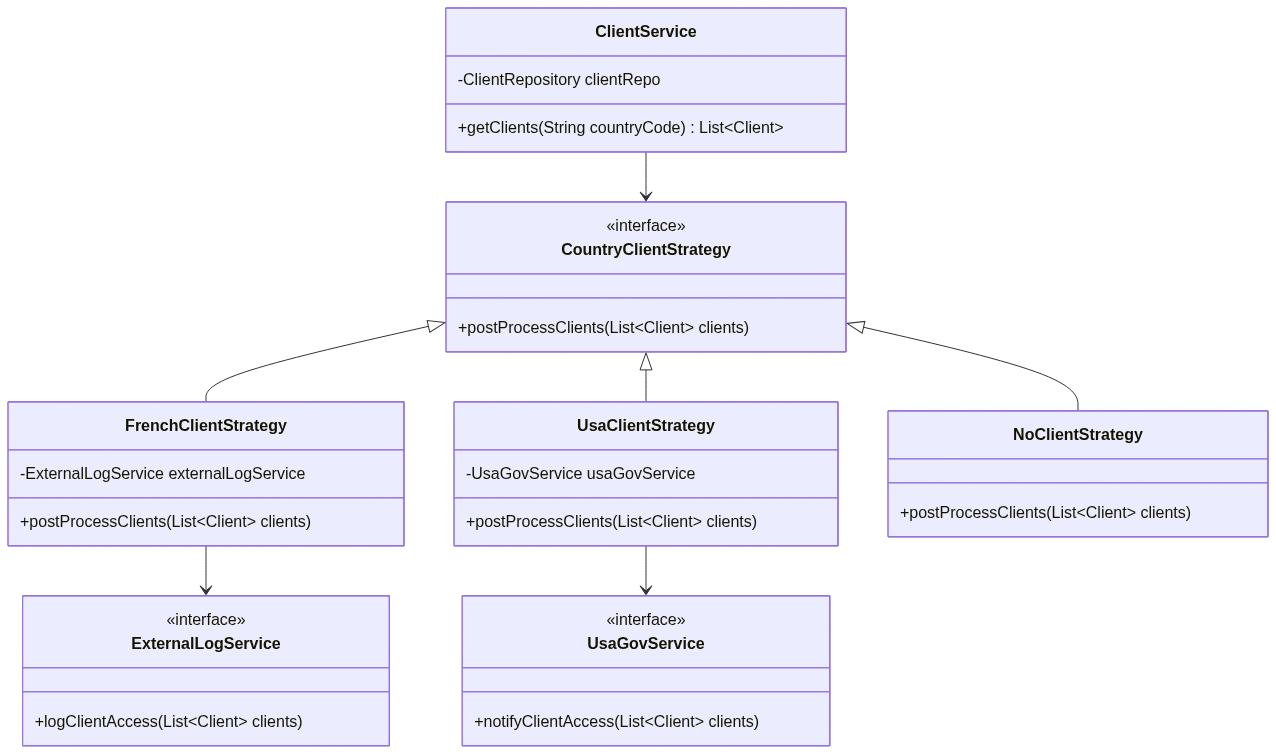The Strategy Pattern is a powerful design solution that transforms complex conditional logic into clean, maintainable, and extensible code. This article explores a real-world implementation where we’ll tackle the challenge of managing country-specific business rules in a client management system.
Real-world example Link to heading
Imagine managing a client data service that needs to follow distinct regulatory requirements for each country before return the list of clients:
- logging access in France and saving in database
- notifying government agencies in the USA
- while requiring no special handling in Germany.
How do you implement these varying behaviors without creating a maintenance nightmare?
The bad code Link to heading
public class BadClientService {
public List<Client> getClients(String countryCode) {
List<Client> clients = clientRepo.findAll();
// Regulation obliges us to log with national specificities
// Bad practice: Long if-else chain mixing different concerns
if (countryCode.equals("FR")) {
clientLogRepository.save("Read list of client : " + clients.size());
} else if (countryCode.equals("US")) {
usaGovService.notifyClientAccessAsync(clients)
.thenAccept(response -> log.info("Notification sent: {}", response));
} else if (countryCode.equals("DE")) {
// Nothing
}
// Bad practice: What if we need to add more regions?
return clients;
}
}
This problematic implementation has several issues:
- Violates Open-Closed Principle: Need to modify existing code to add new countries
- Code Duplication: Country-specific logic needs to be repeated for each method
- Poor Separation of Concerns: Service class knows too much about each country’s specific requirements
- Hard to Reuse: Country-specific logic is trapped inside the service class
With Strategy Design Pattern Link to heading
I’ll help you design a flexible service layer architecture using the Strategy pattern combined with a factory to handle different country-specific behaviors. This will make it easy to add new countries without modifying existing code.
Define the strategies Link to heading
The Strategy pattern is implemented by defining a simple contract CountryClientStrategy with a single method postProcessClients(List<Client>), allowing each country to encapsulate its unique regulatory requirements.
// Strategy interface for country-specific behavior
public interface CountryClientStrategy {
void postProcessClients(List<Client> clients);
}
Each implementation will define the concrete code for the regulation.
// Implementation for France
public class FrenchClientStrategy implements CountryClientStrategy {
@Autowired
private final ClientLogRepository clientLogRepository;
@Override
public void postProcessClients(List<Client> clients) {
clientLogRepository.save("Read list of client : " + clients.size());
}
}
// Implementation for USA
public class UsaClientStrategy implements CountryClientStrategy {
@Autowired
private final UsaGovService usaGovService;
@Override
public void postProcessClients(List<Client> clients) {
usaGovService.notifyClientAccessAsync(clients)
.thenAccept(response -> log.info("Notification sent: {}", response));
}
}
// Implementation for country without regulation
public class NoClientStrategy implements CountryClientStrategy {
@Override
public void postProcessClients(List<Client> clients) {
// No additional processing needed
}
}
Rewriting the service layer Link to heading
The service layer is rewritten by removing the conditional logic and replacing it with a call to the right strategy class.
public class ClientService {
private final ClientRepository clientRepo;
private final CountryClientStrategyFactory strategyFactory;
public ClientService(ClientRepository clientRepo, CountryClientStrategyFactory strategyFactory) {
this.clientRepo = clientRepo;
this.strategyFactory = strategyFactory;
}
public List<Client> getClients(String countryCode) {
List<Client> clients = clientRepo.findAll();
// Select the right strategy to use (no if-elseif)
CountryClientStrategy strategy = strategyFactory.getStrategy(countryCode);
strategy.postProcessClients(clients); // call it
return clients;
}
}
Factory for creating country-specific strategies Link to heading
The Factory pattern plays a crucial role in our country-specific client processing system by elegantly solving the challenge of strategy instantiation and selection. Instead of cluttering our service layer with complex object creation logic or hard-coding strategy selection, the factory acts as a centralized “strategy registry”. When a new country needs to be supported, we simply register its strategy implementation with the factory - no need to modify existing code or add new conditions.
public class CountryClientStrategyFactory {
private final Map<String, CountryClientStrategy> strategies;
public CountryClientStrategyFactory() {
strategies = new HashMap<>();
// Register strategies by country code
strategies.put("FR", new FrenchClientStrategy());
strategies.put("US", new UsaClientStrategy());
strategies.put("DE", new NoClientStrategy());
}
public CountryClientStrategy getStrategy(String countryCode) {
return strategies.get(countryCode);
}
}
Without a factory, we’d need to either manually instantiate strategies (leading to tight coupling) or create complex if-else chains to select the appropriate strategy (violating the Open-Closed Principle).
Benefits Link to heading
This architecture offers several benefits:
- Open/Closed Principle: You can add new country strategies without modifying existing code
- Single Responsibility: Each strategy handles only its country-specific logic
Adding a new country regulation Link to heading
If we open up to a new country, we’ll be able to respond to regulation effortlessly. Simply create a new strategy class and add it to the factory.
public class CanadianClientStrategy implements CountryClientStrategy {
@Override
public void postProcessClients(List<Client> clients) {
// Do something
}
}
// Then in the factory, add:
strategies.put("CA", new CanadianClientStrategy());
